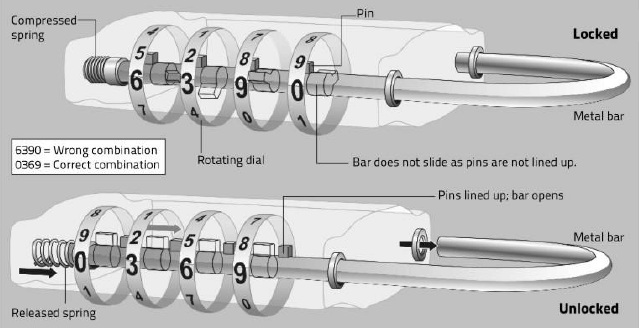A combination lock is activated by twisting a dial, pushing buttons or manipulating a row of movable numbers, as on a suitcase, Whatever the form, the operating principle is the same. All such locks open with the entering of a correct sequence of numbers which have either been set by the manufacturer or changed by the owner. The type of lock used as padlock for doors and bikes is good example to explain the internal working. It has a series of notched wheels with a looped metal bar running through them. The bar has as many bumps as the wheels, but until the notches catch onto these protrusions, the bar remains restrained and cannot slide out. (See the diagram below). The lock opens only when the proper sequence of numbers is selected and wheels are turned accordingly.

For safe, a dial-type lock is used which is more Complex. There is a numbered dial which is turned to achieve the particular combination of numbers. Behind the dial, there are usually three wheels and each turns according to its one respective number set by moving the dial. When the first number is set, a metal pin attached to it turns the first wheel. The metal pin fits through the notch of the wheel. This wheel does not move in subsequent operations. The second number dial aligns the slot of the middle wheel with that of the first and, finally, the third wheel’s slot is aligned, and the bolt then is released.
The combination locks are among the most secure. If the dial has 100 numbers. On it, then there are 100 possible positions of alignment for each of the three wheels-and a total of one million possible combinations for the lock. Addition of a fourth ring or wheel will increase this by a factor of 100 and make it impossible for anyone to discover the combinations of locks. The numbers can easily be changed, and there are innumerable variations today in the basic designs of Combination locks.